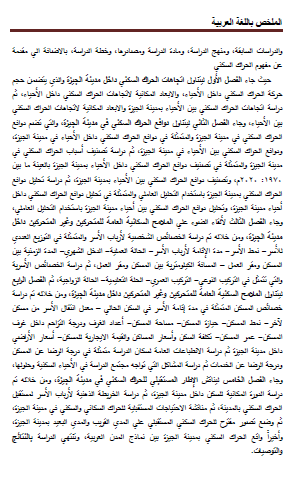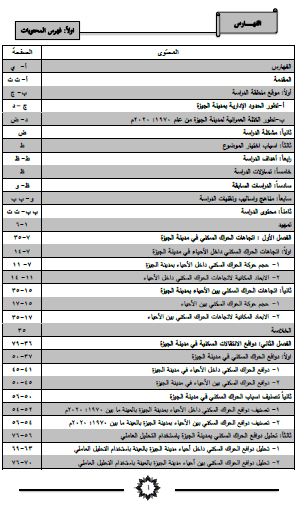الحراك السكني في مدينة الجيزة(دراسة في جغرافية العمران) هاجر عزت عرفة
Residential Mobility In Giza City
A Study in Geography of Settlement
رسالة مقدمة لاستكمال متطلبات الحصول على درجة الماجستير
في الآداب من قسم الجغرافيا بكلية الآداب - جامعة القاهرة
إعداد الطالبة
هاجر عزت عرفة إبراهيم
معيدة بقسم الجغرافيا - كلية الآداب - جامعة القاهرة
إشراف
أ. د. أشرف علي عبده علي
أستاذ جغرافية العمران ونظم المعلومات الجغرافية
كلية الآداب - جامعة القاهرة
القاهرة
2022م
الملخص باللغة العربية
الحراك السكني في مدينة الجيزة
دراسة في جغرافية العمران
إعداد
هاجر عزت عرفة
تحت إشراف
أ.د. أشرف علي عبده
يقصد بالحراك السكني تغيير محل السكن أو محل الإقامة السابق بمحل إقامة
آخر داخل الحدود الإدارية للمدينة، ويطلق عليه أحياناً الهجرة داخل
المدينة، ويعد الحراك السكني أحد أهم الخصائص المميزة للمدن وللحياة
الحضرية، لما له من جوانب كثيرة ترتبط ارتباطاً وثيقاً بالتخطيط الحضري
والاتجاهات العامة لنمو المدن والتغیر في التوزیع السكاني بالمدینة فلا
تخلو أحياء المدن اليوم من التحركات المستمرة متعددة الاشكال والأهداف
والاسباب التي ترتبط بعدد من الخصائص والمتغيرات التي تدفع السكان نحو
الانتقال من مساكنهم.
ويعتبر الحراك السكني أحد عوامل التغير الأساسية في البنية الاقتصادية
والاجتماعية والمكانية للمناطق الحضرية، حيث يعتبر نتيجة للتغير في المناطق
والأحياء السكنية داخل المدن، وهناك اعتقاد أن دراسات الحراك السكني تسهم
في فهم التحركات السكنية والسكانية وحجمها واتجاهاتها وخصائصها وكذلك فهم
الدوافع المتعلقة بها، حيث يُحدث الحراك السكني تغير كبير في المناطق
السكنية المتجهة لها أو الخارجة منها.
وقد شهدت المدن توسعات وتحركات سكانية سريعة بين مناطقها السكنية
وأحيائها، وعلى الرغم من أهمية الانتقال السكني وتأثيره على خصائص الأحياء
وتأثره بها، وارتباط ذلك كله بالتخطيط الحضري، فإن الدراسات المتعلقة
باتجاهات التحركات السكنية وأسبابها وخصائصها محدودة ونادرة حيث مثلت تمك
الدراسات نحو 1.6% (دراستان) من إجمالي الدراسات داخل الدوريات العربية،
على حين مثلت تلك النسبة حوالي 3.3% من إجمالي الدراسات غير العربية في دول
العالم المتقدم خلال الفترة ما بين 1995 - 2017م.
وتأتي هذه الدراسة لمحاولة فهم الحراك السكني داخل مدينة الجيزة في إطار
زمني من عام 1970 حتى عام 2020م، ووضع تصور مستقبلي حتى عام 2050م، وتتكون
الدراسة من خمسة فصول يسبقها مقدمة ويعقبها خاتمة، وتحتوي المقدمة على
أسباب اختيار الموضوع، وأهداف الدرسة، والدراسات السابقة، ومنهج الدراسة،
ومادة الدراسة ومصادرها، وخطة الدراسة، بالإضافة إلى مقدمة عن مفهوم الحراك
السكني.
حيث جاء الفصل الأول ليتناول اتجاهات الحراك السكني داخل مدينة الجيزة
والذي يتضمن حجم حركة الحراك السكني داخل الأحياء، والأبعاد المكانية
لاتجاهات الحراك السكني داخل الأحياء، ثم دراسة اتجاهات الحراك السكني بين
الأحياء بمدينة الجيزة والأبعاد المكانية لاتجاهات الحراك السكني بين
الأحياء، وجاء الفصل الثاني ليتناول دوافع الحراك السكني في مدينة الجيزة،
والتي تضم دوافع الحراك السكني في مدينة الجيزة والمتمثلة في دوافع الحراك
السكني داخل الأحياء في مدينة الجيزة، ودوافع الحراك السكني بين الأحياء في
مدينة الجيزة، ثم دراسة تصنيف أسباب الحراك السكني في مدينة الجيزة
والمتمثلة في تصنيف دوافع الحراك السكني داخل الأحياء بمدينة الجيزة
بالعينة ما بين 1970 : 2020م، وتصنيف دوافع الحراك السكني بين الأحياء
بمدينة الجيزة، ثم دراسة تحليل دوافع الحراك السكني بمدينة الجيزة باستخدام
التحليل العاملي والمتمثلة في تحليل دوافع الحراك السكني داخل أحياء مدينة
الجيزة، وجاء الفصل الثالث لإلقاء الضوء على الملامح السكانية العامة
للمتحركين وغير المتحركين داخل مدينة الجيزة، ومن خلاله تم دراسة الخصائص
الشخصية لأرباب الأسر والمتمثلة في التوزيع العددي للأسر- نمط الأسر- مدة
الإقامة لأرباب الأسر- الحالة العلمية- الدخل الشهري- المدة الزمنية بين
المسكن ومقر العمل – المسافة الكيلومترية بين المسكن ومقر العمل، ثم دراسة
الخصائص الأسرية والتي تتمثل في التركيب النوعي- التركيب العمري- الحالة
التعليمية- الحالة الزواجية، ثم الفصل الرابع ليتناول الملامح السكنية
العامة للمتحركين وغير المتحركين داخل مدينة الجيزة، ومن خلاله تم دراسة
خصائص المسكن المتمثلة في مدة إقامة الأسر في السكن الحالي – معدل انتقال
الأسر من مسكن لآخر- نمط المسكن- حيازة المسكن- مساحة المسكن- أعداد الغرف
ودرجة التزاحم داخل غرف المسكن- عمر المسكن- تكلفة السكن وأسعار المساكن
والقيمة الايجارية للمسكن- أسعار الأراضي داخل مدينة الجيزة، ثم دراسة
الانطباعات العامة لسكان الدراسة متمثلة في درجة الرضا عن المسكن ودرجة
الرضا عن الخدمات ثم دراسة المشاكل التي تواجه مجتمع الدراسة في الأحياء
السكنية وحلولها، وجاء الفصل الخامس ليناقش الإطار المستقبلي للحراك السكني
في مدينة الجيزة، ومن خلاله تم دراسة الدورة المكانية للسكن داخل مدينة
الجيزة، ثم دراسة الخريطة الذهنية لأرباب الأسر لمستقبل الحراك السكني
بالمدينة، ثم مناقشة الاحتياجات المستقبلية للحراك السكاني والسكني في
مدينة الجيزة، ثم وضع تصور مقترح للحراك السكني المستقبلي على المدى القريب
والمدى البعيد بمدينة الجيزة، وأخيراً واقع الحراك السكني بمدينة الجيزة
بين نماذج المدن العربية، وتنتهي الدراسة بالنتائج والتوصيات.
Residential Mobility In Giza City
A Study in Geography of Settlement
Geographical Study Thesis Submitted for Obtaining Master Degree from Faculty Of
Arts, Geography Department, Cairo University
Prepared By
Hager Ezzat Arafa Ibrahim
Demonstrator, Geography Department
Faculty of Arts – Cairo University
Supervised By
Prof. Dr. Ashraf Ali Abdou
Prof. of Geography Of Settlement &Geographical Information
Systems, Faculty of Arts , Cairo University
Cairo
2022
الملخص باللغة الإنجليزية
Summary
Residential Mobility in Giza City: A Study in Geography of Settlement
Prepared by:
Hager Ezzat Arafa
Supervised by:
Prof. Dr. Ashraf Ali Abdou
Residential mobility is defined as the changing of housing places or
changing accommodation within the administrative boundaries of the city.
It is - sometimes – referred as migration within the city, intra- urban
migration, or residential transition. The residential mobility is
considered as one of the most important distinctive characteristics of
cities and urban life, and one of the main factors behind the
vicissitudes of spatial and economic and social structure within the
city owing to many aspects closely related to urban planning. City
districts are in the state of permanent residential mobility that incur
various structures, reasons, and goals that may be related to the number
of variables and characteristics that push away the population towards
the transition from their residents.
Residential mobility is one of the main factors of changing in the
economic, social and spatial structure of urban areas as it is
considered as a result of change in residential areas and neighborhoods
within cities. There is a belief that the studies of residential
mobility have contributed to understand the residential movements
followed by population movements, its magnitude, trends, and
characteristics. These studies also contribute to the understanding of
the motives and driving forces behind residential mobility as it
significantly affects the residential areas destined for or out of it.
Cities have witnessed rapid expansions and population movements between
its residential areas and neighborhoods. In spite of the importance of
population transfer and its impact on the characteristics of
neighborhoods and its effect that would be linked to urban planning, the
published Studies that dealt with the characteristics of housing
movements and with the trends causes' are still limited and rare.
These studies represented about 1.6% (two studies only) out of the
total studies within the Arabic periodicals, while on the hand it
represented about 3.3% of the total non-Arabic studies in the developed
world.
This study attempts to understand the residential mobility within Giza
city in a timeframe that consist of a time period from 1970 to 2020.
Moreover, it generates and depict a future vision until 2050. The
present study consists of five chapters preceded by an introduction and
ended by a conclusion. The introduction contains the rationale behind
selecting the topic of study, objectives, literature review of previous
studies, approaches of study, sources of study, and the study contents.
In addition to these, the introduction deals with the concept of
residential mobility.
Chapter
I deals with The Trends of Residential Mobility Within Giza City, which
includes its magnitude and trends spatial dimensions in two scales, the
first: is within the neighborhoods administrative units itself and the
second: is between each neighborhood with other administrative units of
the city.
Chapter
II came to deals with The Motives of Residential Mobility in Giza City,
which includes residential mobility and its motives within
neighborhoods administrative scale in Giza city. Moreover, it discusses
and then studying and analyzing the classification of its main causes of
the taken sample size in the period from 1970 to 2020. In addition to
this, the motives of residential mobility among neighborhoods were
studied and classified. The study sheds light on the analysis of the
mentioned above motives by using a statistical factor analysis among and
between the neighborhoods of the city.
Chapter
III discusses and studies The General Demographic Features of Movable
and Immovable Population in Giza City. Focusing on studying the follows:
personal characteristics of heads of families, were studied, the
spatial distribution of families, type of families, length of residence
for heads of families, work status, monthly income, the period of time
between housing and the workplace, and the distance in kilometer between
the residence and the workplace. Also, it studies the family
characteristics which are represented in the qualitative composition,
the age and sex structure, the educational status, and the marital
status.
Chapter
IV deals with The General Residential Features of the Movable versus
the Immovable Population in Giza City. Dwelling characteristics were
studied and represented during the occupation period of the studied
families. Furthermore, this chapter is concerned demonstrating several
variables such as: the rate of movable families from one resident to
another, resident type, types of resident's possession, resident size,
average number of rooms and degree of crowding, " resident age,
ownership cost, and rental value", and land prices within the city. The
chapter ends with the study of the general impressions of the residents
which were represented in measuring the degree of satisfaction, and the
degree of satisfaction with the offered services. Then studying the
problems facing the study community in residential neighborhoods and
their solutions.
Chapter V projects and displays The Future Framework of the Residential
Mobility in Giza City. It also sheds light on the spatial cycle of
housing, then studying the mental map of heads of families for the
future of the housing movement in the city. It discusses also the future
needs of both demographic and residential mobility. Additionally, this
thesis developed a proposed vision for the future residential mobility
in the city both on the short run term and long run term, and finally it
compares the existing residential mobility with other models of Arabic
cities.
Finally, the study ends with a conclusion that contains its most crucial findings and thesis recommendations.
تحميل الرسالة
للاطلاع والتحميل الرسالة

















